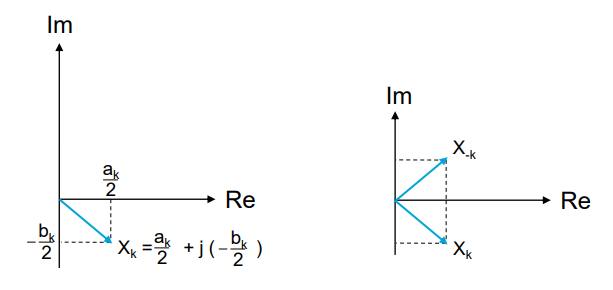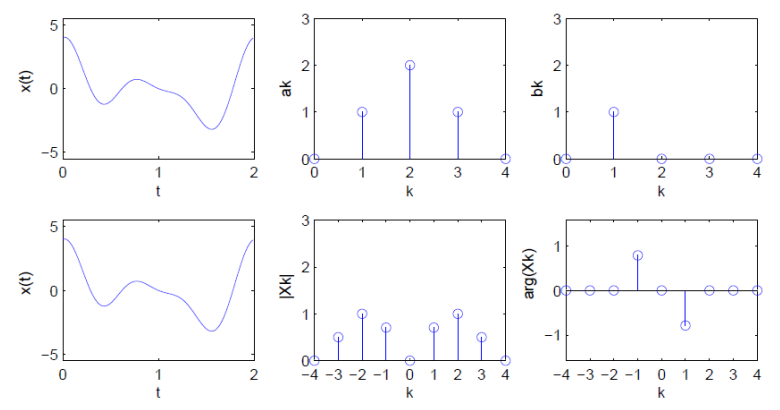3.2. Complex Fourier Series#
A quick recap#
From the previous chapter, we have found that any periodic signal can be written into series of harmonically related sinusoids:
where the coefficients can be found as:
Now the same signal decomposition, but in a different form using complex algebra as commonly done in spectral analysis of signals, will be used.
Complex Algebra#
\(j\): imaginary unit (or number) such that \(j^2=-1\)
\(e\): Euler’s number (base of the natural logarithm), \(e\approx 2.71\)
Euler’s formula:
and, therewith:
Complex Fourier Series#
First equation is known as synthesis equation of Fourier Series, as in contructs the signal using complex exponential basis functions
Second equation is known as analysis equation of Fourier Series, as it allows us to analyze how signal can be represented by complex exponential basis functions (where index \(k\) refers to frequency \(k\omega_0=k2\pi f_0\)).
MUDE Exam Information
This derivation is provided for additional insight and will not be part of the exam.
Start by substituting the complex exponential forms of both \(\cos(k\omega_0 t)\) and \(\sin(k\omega_0 t)\) into trigonometric series:
If we replace the last term index \(-k\) for \(k\) then we get:
As when \(k=0\) we have \(X_k=X_0=a_0\) and \(e^{jk\omega_0 t}=e^{j0\omega_0 t}=1\), then we can compact everything and write
where
Coefficients#
Real and complex Fourier series coefficients are related by:
so
And we clearly see that \(X_k=X^*_{-k}\), with \(*\) denoting the complex conjugate. The visual representation of \(X_k\) and \(X_{-k}\) will be, therefore:

We have \(a_k=2\text{Re}(X_k)\) and \(b_k=-2\text{Im}(X_k)\) for \(k>0\)
Visualising complex coefficients \(X_k\) as vectors in complex plane: magnitude, or modulus (amplitude), and argument, or phase. We can write the coefficients in polar (or phasor) form:
and we find:
Magnitude \(|X_k|=\frac{1}{2}\sqrt{a_k^2+b_k^2}\), k>0
Argument \(\theta_k=\arctan\left(-\frac{b_k}{a_k}\right)\), k>0
For real signals \(x(t)\), as we use in this practical course, we have \(|X_k|=|X_{-k}|\) and \(\theta_k=-\theta_{-k}\)
Line Spectra#
The complex exponential Fourier series coefficients
shows amplitudes of all phasors involved, through modulus of complex exponential coefficients \(|X_k|\) versus frequency \(kf_0\), yields amplitude spectrum (actually magnitude spectrum)
shows phases of all phasors, through argument of the complex exponential coefficients \(\theta_k\) versus frequency \(kf_0\), yields phase spectrum
Example#
Consider the following signal, with period \(T_0=2s\), so \(f_0=0.5\) Hz, composed of three cosines and one sine:
Real and complex Fourier coefficients are shown below

Summary#
The complex exponential Fourier series is given by
with coefficients
The complex coefficients can be written in polar form: \(X_k=|X_k|e^{j\theta_k}\)
then, for real signals:
magnitude: \(|X_k|=|X_{-k}|\), even function of \(k\) (and hence frequency \(kf_0\)) forming amplitude spectrum
argument (or phase): \(\theta_k=-\theta_{-k}\), odd function of \(k\), forming phase spectrum
\(\implies\) periodic signal written in terms of sum of cosines and sines, together (pairwise) represented in complex exponentials
Attribution
This chapter is written by Christiaan Tiberius. Find out more here.
